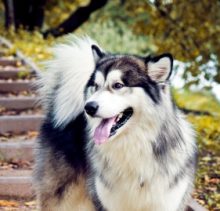Alaskan Malamute
Lifestyle Needs

The Alaskan Malamute is a big dog, weighing around 38-50 kilograms. His purpose is to pull sledges and therefore is very strong, often not aware of his enormous strength. He needs physical and mental challenges or he could become destructive. His owner needs to be prepared to invest time into training. The Malamute has a thick, coarse outer coat and a woolly undercoat so is happy in very cold weather. He definitely does not suit a warm climate and on warm days will need to be kept cool. He will need to live in a house with a garden and should have plenty of exercise. Grooming is challenging and this dog needs grooming frequently and to be professionally groomed once or twice a year
Genetic Diversity
(Known as Coefficient of Inbreeding: 'COI'. It should be as low as possible.)
The UK Kennel Club breed average COI is 8.0% - See 'A Beginners Guide to COI'
Gene Pool Size
(Known as Effective Population Size: 'EPS')
TBC
EPS is a measure of how many individuals are contributing genetically to a breed population. It is a measure of the size of the gene pool in a breed. Lower than 100 is considered critical by conservationists and below 50 brings a breed close to extinction. For more information see the Kennel Club article.
Health and Welfare Problems due to Conformation
(Body shape and physical characteristics)
- The Malamute is ideally suited to his homeland but elsewhere he will suffer in warm temperatures because of the thickness of his coat.
BVA/KC Health Schemes: www.bva.co.uk/chs
- Hip dysplasia Breed 5 year mean score 10 (ideally parents should be lower)
- Eye disease: Hereditary cataract (HC) (annual examination)
Estimated Breeding Values (EBVs) : EBVs for Hip Dysplasia are available for this breed
www.thekennelclub.org.uk/about-ebvs
DNA Tests Available
DogWellNet and IPFD Harmonisation of Genetic Testing for Dogs (HGTD)
www.dogwellnet.com/breeds
- Cone degeneration (CD) (Achromatopsia)
- Urinary stones
- Polyneuropathy (AMPN)
- Degenerative myleopathy
Availability of a DNA test does not mean that it is always necessary or even desirable for breeders to use this test.
Other Breed-Specific Health Screening Schemes
- Bitches not to be mated before third season
- Bitches not to produce a litter under two years of age
- Bitches not to produce more than one litter within a 12 month period.
Ask the breeder to show you the certificates for the above tests/screening for both parents. If any of the above tests have not been considered necessary by the breeder (and there may be good reasons), ask her to explain why.
Other Diseases Reported
(For which there are currently no genetic or screening tests for sire or dam)
- Thyroid disease
- Pancreatitis
- Cancer: Tracheal and laryngeal tumours; sebaceous gland tumours
- Gastric dilatation volvulus (GDV) (Bloat/torsion)
- Gangliosidosis (GNI)
- Cranial cruciate ligament disease (CLL)
- Haemophilia B
Ask the breeder about the medical history of the parents, grandparents and great grandparents. Consider carefully whether to purchase a puppy if some of these or other diseases are in the family line.
Ask about the breeder’s policy in cases of serious genetic diseases occurring to your puppy in later life. Good breeders will request to be informed of such events in order to improve future breeding decisions.
You are strongly advised to buy from a breeder who uses (or is prepared to use) the AWF Puppy Contract and Puppy Information Pack (PIP): www.puppycontract.org.uk
The breeder should also be familiar with the CFSG/DBRG Code of Practice for Dog Breeding